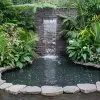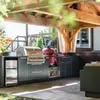Preparing the pavement for winter
- Date : Friday, October 28th, 2022
- Read time : 3 min
Leaf collection brings its share of controversy. Some will say that leaving dead leaves on the lawn and shrubs will create an insulating layer during the cold season. Others will have the reflex to collect them for maintenance and aesthetics.
One thing is certain, we strongly advise you to remove the dead leaves from your pavement. The natural dye of the leaves could stain the paving stones when they decompose and the accumulation of rain or snow. By removing the leaves in the fall, you will avoid unpleasant surprises in the spring.
Did you know that the moisture that accumulates in the plants located near your paving stone could be the cause of moss growth in the paving stone joints? Indeed, shrubs that grow during the summer can create shade on the paving stone. Combined with the humidity of fall days, this creates the perfect environment for green moss to grow. It is best to trim back any shrubbery branches that overhang your pavement areas.
Counteract freeze-thaw periods
Although soil compaction is done accordingly, the freeze-thaw period usually causes movement in paver slabs. To mitigate the risk of warping, consider removing heavy objects such as decorative pots, furniture or umbrella bases.
Ice
Ice buildup on paving stones is often caused by water dripping from gutters. To maximize your safety, and avoid potential problems, adding gutter extensions may be the solution.
If you notice that some joints are less filled or that holes have formed, it is important to add polymer sand. This way, you will avoid the accumulation of water which, with the freezing, will create ice and could make the tiles move.
Snow removal
When it comes to snow removal, it is important to choose a plastic or fiberglass shovel. Avoid using a concrete shovel, as it could damage your pavement. If you plan to use salt or other types of snow melters, be sure to choose de-icers specifically designed for pavement.
Magnesium chloride is generally more expensive than regular salts, but it is very effective. Although it contains less chlorine than calcium chloride, its characteristics are comparable to those of calcium chloride. It is effective at temperatures as low as -25°C. This type of salt is the least damaging to concrete. Moreover, it is non-toxic for vegetation and animals when used according to recommendations. De-icing salt is available at hardware and big box stores.
By following these tips, you can avoid many problems and keep your pavement looking clean and new.





